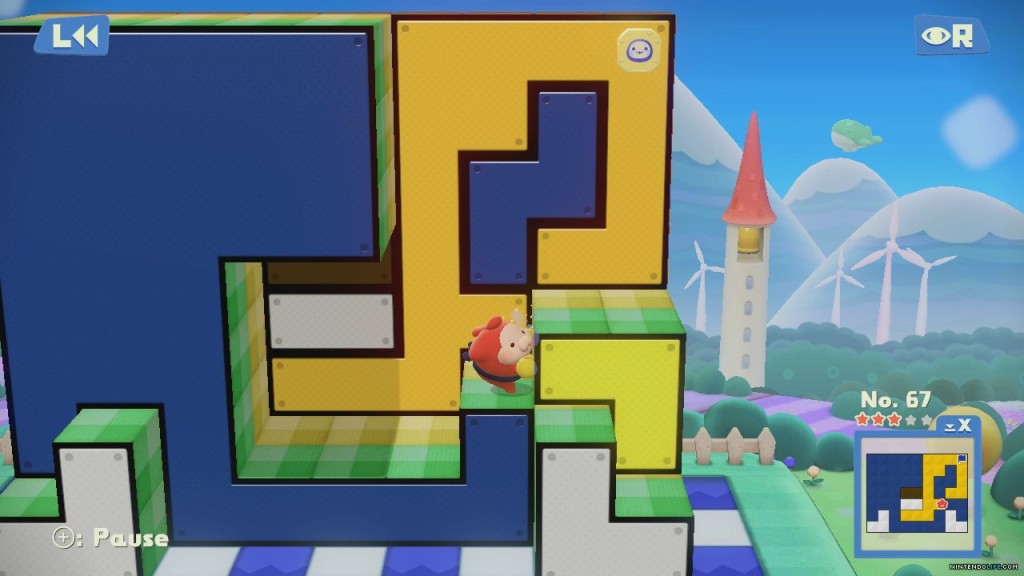Thanks to the generous nature of Club Nintendo’s free gift giveaway for Platinum members (RIP), I ended up receiving a copy of Pushmo World for free. Let me say that receiving something for free does not often make you think it may be your most played game on a video game system within a certain year (excluding the PC, of course). Pushmo World, at least in that sense, usurps expectations, but it does much more than that. Rather, Pushmo World is the best example of the “puzzle” genre as it was once known, a deft combination of escalating difficulty and brain-teasing arrangements that will test your skills in logical deducation in nearly every instance of its 250+ levels.
But, I get ahead of myself. Developed by Intelligent Systems, mostly known for Fire Emblem and Advanced Wars, Pushmo World initially seems like a port of a 3DS game called Pushmo, a take off Sumo if I had to guess (he pushes blocks, not people; just look at that top bun and that thong thing, and you tell me the protagonist does not represent a fun Japanese in-joke). Pushmo tasks the player with a simple task: save the little kid stuck in the block at the top of the screen (which sounds horrific). Each stage contains a number of blocks you can push and pull out, each with a maximum of three different layers. In a sense, you’re doing a bit of reverse platforming; you need to figure out where each block needs to be, what length, and what configuration so that you can steadily proceed to the top. The little sumo dude you control can jump, but rather ineffectively; at best, it will move you from one block to another at about two block lengths, but rarely more than that. As such, figuring out the order of block movement remains a far more pressing task.
None of this sounds particularly exciting in text, but I assure you playing the game itself works wonders. There’s an elegant simplicity to the majority of the puzzles that never quite escapes the game designers. You push, pull, and move the blocks every which way in a delightfully complex attempt to achieve something very banal, and yet I do not care. The journey becomes much more important than the destination as Pushmo World pushes (har har) you to look outside the box.
There’s plenty of advanced techniques as well! Over time, you will learn that most puzzles contain one solution, but each of those solutions requires knowing how you can move blocks. You need at least two push-out blocks worth of clearance to push other blocks out, and you also cannot stand on a block and push/pull a block at the same time. These limitations make for very interesting puzzle designs; you’ll often need to find out how, exactly, you must push a seemingly immovable block outwards in order to solve the puzzle. Furthermore, the three-fold model tends to work incredibly well for puzzle designs. Knowing that you have three layers means, in some cases, the creation of an arbitrary three-fold stair case just via the blocks present. Seeing how the whole puzzle moves when you move a block proves a worthy challenge, in any event. Part of the fun sits in seeing how various parts of the whole react to tiny movements, and how to get there will sometimes wrack your brain. Since you can view the entire block-based edifice at any time, you can calculate your move in order, should you choose…or simply bash your head against the wall with constant trial and error, as is my modus operandi. Since no time limit exists, Pushmo World encourages everyone to try their hardest at these dense puzzle games, and I think it works for just about anyone.

In puzzle games, everyone’s brain tends to work differently, and that’s no different here. I’m not sure I would call this a fault of the genre, since a designer can only go so far to read the minds of those trying to solve intentionally difficult puzzles. Some just skew too easy, and I’m not sure whether that’s due to my own video game experience or simply due to a need for pacing in the game’s main 250 puzzles. That probably explains additional nuances in the form of “ladders”, more like manholes. They act mostly as teleportation devices that move you from one color-coded location to the next. Obviously, moving blocks will expose or close up a corresponding color-coded manhole, so you will need to find out how to get up there using that tool. Honestly, these puzzle tend towards the more straightforward, and they tend toward the easiest. If they made them any more complex, I imagine people would tear their hair out trying to figure out how to get from green to red to purple to orange to magenta to whatever, so they give your brain a little break with clear chunking potential.
At any point, the game offers a reset button (to push all the blocks back to their original position) and a “rewind ” button to move back a way, since the game’s always recording your movements, which also alleviate the bizarre tedium of solving a block puzzle over and over again. Sometimes, you just need the game to remove one unrepeatable step you made, and Pushmo gives you that opportunity. Rarely do I like features that let you “rewind”, especially in racing games (the whole point is consistency in that genre, after all), but in Pushmo World it works. They figure if you’re stuck, you would be stuck anyway, but if you figured it out and made a wrong move several steps back, you can correct it. I can’t tell you how many times that happened to me, where I remained one step away from the goal, only to see the exact wrong and a subsequent U-turn back to the right path.

Then, you obtain the euphoric plateau of endorphin rush from solving a particularly nasty set, and the “EURKEA” that follows soon after. Pushmo World makes you feel smart, and I would say that feeling is often quite genuine. There really is, in almost every case, one solution, and finding that exact solution takes tons of effort. Some of the simplest looking puzzles end up becoming the most devious, where little movements can often alter your ability to finish without even a whiff of perception on your part. Tracking the right path, though, definitely seems worth it in the end. I guess what I see in Pushmo World applies in real life as well: anything worth doing takes lots and lots of effort. The results seem delayed, because we always want it immediately, but the long-term gain gives us far more than we could possibly imagine.
13 “Enter through the narrow gate; for the gate is wide and the way is broad that leads to destruction, and there are many who enter through it. 14 For the gate is small and the way is narrow that leads to life, and there are few who find it.
Matthew 7:13-14
So, have I actually finished Pushmo World? Nope! And not for lack of trying, but time. You see, finishing the 250 puzzles, plus the challenge mode puzzles, plus timed practice puzzles, plus user created content, would probably take up all the time in the world. This isn’t really a game you play in one sitting, but one where you play, get stumped, think about something else, and then finally reach the conclusion yourself. I like the self-motivated nature of such games; they give you an agency you rarely see to solve things on your own time, a different sort of challenge from my usually reflex-based preference. If you’ve got $9.99 and a hankering for an old console-style puzzle game, Pushmo World should be your jam.
